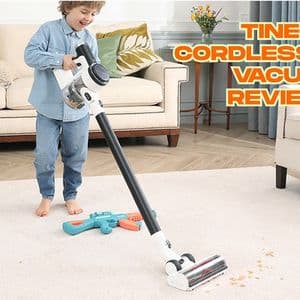What Is a Wireless Vacuum?
A wireless vacuum is a cleaning device powered by a rechargeable battery rather than a direct electrical connection. This design removes the limitations of cords, making it possible to clean anywhere without being tethered to an outlet.
Over the years, these vacuums have evolved from lightweight tools for quick messes to full-featured machines capable of deep cleaning carpets and hard floors. The combination of portability and power has made them a go-to option for households seeking efficient and hassle-free cleaning solutions.
How Wireless Vacuums Work
So, how do these devices actually operate? A built-in battery stores energy that powers a motor, which creates suction to lift dust, dirt, and debris from surfaces. The debris is then collected in a dustbin, which can be emptied after use.
Modern models often feature multiple cleaning modes. For example, a lower-power mode extends battery life for light cleaning, while a high-power mode boosts suction for tackling stubborn messes. This flexibility ensures users can adapt the vacuum’s performance to their immediate needs.
Key Benefits of Going Wireless
Here’s why many people are making the switch:
1. Freedom of movement
Without a cord, users can move freely between rooms, up staircases, and even outside to clean cars or patios.
2. Faster cleaning sessions
No more stopping to plug and unplug. This can significantly reduce total cleaning time, especially in larger spaces.
3. Versatility across surfaces
Wireless vacuums can transition between carpets, hardwood, and tile with minimal adjustments, making them a versatile cleaning tool.
4. Easy storage
Most models are slim and lightweight, allowing for vertical storage in closets or on wall mounts.
Battery Life and Charging Considerations
Battery performance is one of the most important factors when evaluating a wireless vacuum. High-capacity batteries can run anywhere from 30 minutes to over an hour, depending on the mode used.
Charging times vary, typically ranging from two to five hours. Some advanced models offer removable batteries, allowing users to keep a spare charged for extended cleaning sessions.
If you plan on deep cleaning multiple rooms, choosing a device with a longer runtime or quick-charging capability is essential.
Comparing Wireless and Corded Vacuums
Let’s face it — corded vacuums have long been the standard for deep cleaning. They offer consistent power and unlimited runtime as long as they’re plugged in. However, they can be bulky and cumbersome to maneuver.
Wireless vacuums, while dependent on battery life, make up for it with unmatched mobility and user-friendly operation. The decision between the two often comes down to lifestyle. For those who value convenience and quick access, a wireless model is often the better choice. For heavy-duty, prolonged cleaning, a corded vacuum might still be preferable.
Maintenance and Longevity
Maintaining a wireless vacuum is straightforward but important for extending its lifespan. Regularly empty the dustbin, clean the filters, and check for blockages in the suction pathway.
Batteries typically last a few years before their performance begins to decline. When that happens, replacing the battery can restore the device’s cleaning power without needing to purchase a whole new unit.
Following the manufacturer’s maintenance guidelines ensures optimal suction and durability over time.
Special Features to Look For
Some wireless vacuums come equipped with advanced features that enhance cleaning efficiency:
-
HEPA filtration for trapping fine dust and allergens
-
LED headlights to illuminate hidden dirt under furniture
-
Convertible designs that switch from full-size to handheld mode
-
Multiple attachments for upholstery, crevices, and pet hair
While these extras aren’t essential, they can make cleaning faster, easier, and more thorough.
Popular Categories and Designs
Within the wireless vacuum market, certain designs stand out. Many consumers favor the slim profile of stick models, especially those competing for the title of the best stick vacuum cleaner. These are lightweight, easy to store, and often have strong suction for their size.
For users with pets or larger cleaning areas, some prefer bulkier models with bigger dustbins and extended battery capacity. Handheld wireless vacuums are another category, ideal for quick spot cleaning or car interiors.
Evaluating Quality and Performance
A good vacuum should balance suction power, battery life, and ease of use. Testing a device across different floor types can reveal how well it adapts to varying cleaning challenges.
Noise levels are another consideration. Quieter models can be more pleasant to use, particularly in homes with children or pets. Build quality, including the durability of joints, dustbins, and handles, also plays a role in long-term satisfaction.
Specialized Brands and Models
Some brands have carved out a strong reputation in the wireless vacuum market. For instance, shark cordless vacuum cleaners are well-known for their combination of portability and effective cleaning features. Other manufacturers focus on extended battery life, lightweight designs, or multi-surface adaptability.
Ultimately, the right choice depends on matching the vacuum’s strengths to the user’s cleaning habits and home layout.
Final Thoughts
A wireless vacuum offers a practical balance between cleaning power and convenience. Its portability makes it ideal for fast cleanups and hard-to-reach areas, while modern advancements have brought battery life and suction strength closer to traditional corded models.
By understanding how these vacuums work, what benefits they bring, and what features to prioritize, you can identify a model that meets your needs without compromise. In today’s fast-paced world, the right cleaning tool can make all the difference in maintaining a clean and comfortable home.










